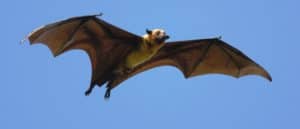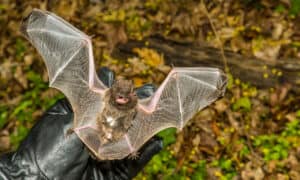Rivers support life in all its forms, including predators and prey. Bats, also known as “guardians of the night,” are the only mammals with wings that can fly. They sleep in safe places during the day and swoop out after sunset to forage for food. Creatures of all kinds stay close to water, including bats, who use it to rehydrate and find insects. Meet the seven types of bats on the Mississippi River, including how to identify them and their habitats.
1. Big Brown Bat (Eptesicus fucus)

The big brown bat is abundant in suburban agricultural areas.
©Jay Ondreicka/Shutterstock.com
Big brown bats are a species of microbat widely distributed in North America. They weigh less than an ounce but are considered big in the vesper community. Their fur is long, oily, and light to dark brown, with a black muzzle and ears. They also have a wingspan of up to 16 inches, short ears, and a wide mouth.
These bats’ range is pretty extensive, from northern Canada down to the tip of Mexico. They are abundant in deciduous forests and suburban agricultural areas, where they like to roost in barns, buildings, and under bridges. While they eat a variety of night-flying insects, big brown bats like small crunchy beetles the best. This particular species shows little preference for habitats and food; they will eat what’s available and sleep wherever.
2. Silver-Haired Bat (Lasionycteris noctivagans)

The silver-haired bat lives in forested habitats, roosting in tree cavities and under the bark.
©Jay Ondreicka/Shutterstock.com
This solitary bat has all black fur with silver tips, giving it a frosted appearance; it also belongs to the vesper (microbat) family. The silver-haired bat has a wide range, reaching from Alaska down to Mexico, where it spends most of its life in forested habitats. Its coloration allows it to roost in tree cavities or bark crevices unnoticed.
Silver-haired bats typically migrate south during winter, but some may overwinter in colder regions if they can find a warm spot in a building. Females hibernate after mating, and bat pups are born in the spring. These slow flyers glide over the water at night near forest openings to catch their dinner. They eat mainly soft insects like moths but occasionally dine on spiders.
3. Eastern Red Bat (Lasiurus borealis)
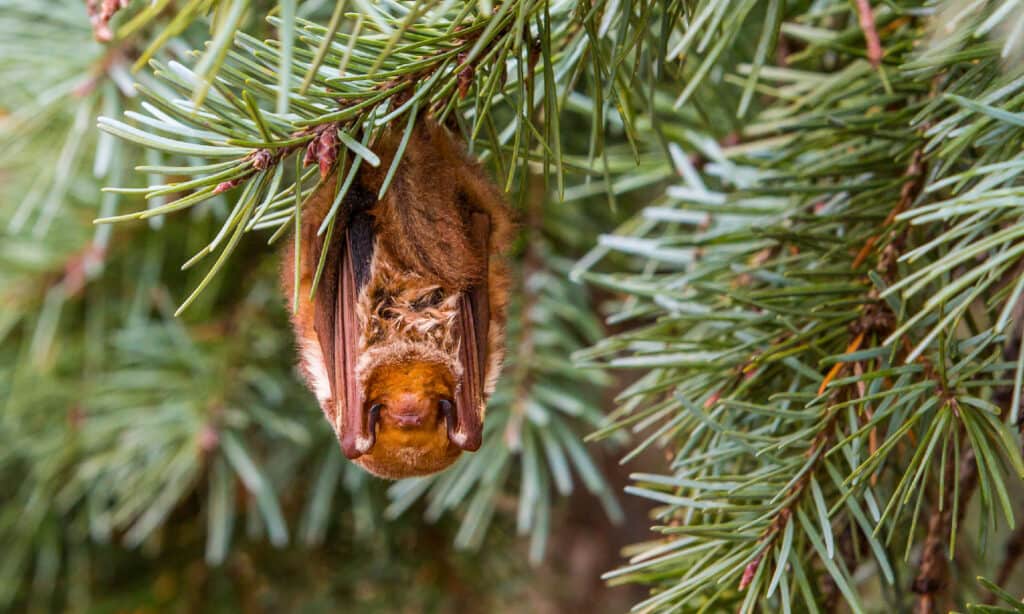
The eastern red bat blends in with foliage, appearing like dead leaves.
©Elliotte Rusty Harold/Shutterstock.com
The eastern red bat is also a microbat and inhabits much of the eastern half of the United States; you can also find it in Southern Canada down to Argentina. This species is a tree bat, about three to four inches in length, and has a wingspan of 13 inches. Its compact body includes small, rounded ears and long reddish-brown fur.
In winter, you can find this bat in the southeastern United States near coastal areas, and in summer, it travels to the Great Lakes and Great Plains regions. The eastern red bat lives in forests among the foliage, whose rusty red color makes it look like dead leaves. Its quick maneuvers allow it to eat its favorite food: moths.
4. Hoary Bat (Aeorestes cinereus)
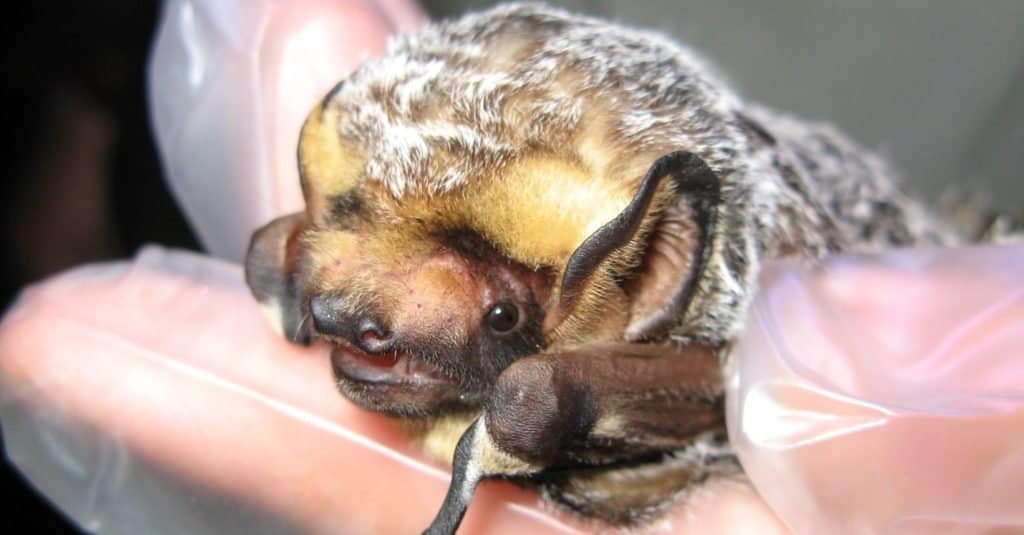
The hoary bat conceals itself in coniferous trees, wrapping its tails around its body.
©Florida Fish and Wildlife / flickr – License
The hoary bat is a microbat, widely distributed throughout North America, from northern Canada to Guatemala. It has a dense coat of dark brown fur with white tips, giving it a “hoary” appearance (grayish-white). This bat is slightly bigger than other bats in its family, almost six inches long and around 0.9 ounces; the females are 40% bigger.
Hoary bats migrate during the spring and fall, hunting at night for insects like moths and mosquitos and consuming 40% of their weight at every meal. They conceal themselves in large deciduous or coniferous trees, hanging upside down by one foot, with their tails wrapped around themselves like a blanket.
5. Little Brown Bat (Myotis lucifugus)

The little brown bat is a mouse-eared microbat abundant in the Northern United States.
©Corina Daniela Obertas/Shutterstock.com
Varying in color, the little brown bat can be brown, red, gold, and even albino. Despite its name, it is not closely related to the big brown bat; it is from the mouse-eared microbat family. This endangered species is native to North America, inhabiting regions from Canada to high-elevation forests in Mexico. However, little brown bats are more abundant in the Northern United States.
Humans encounter these bats reasonably often because they often choose to roost in buildings near people. Their populations are declining quickly from a fungal disease called “white-nose syndrome.” Human control measures also threaten them due to their propensity for transmitting parasites and rabies. Other types of bats on the Mississippi River with large quantities of fungal infections include the tricolored and silver-haired bat.
6. Northern Long-Eared Bat (Myotis septentrionalis)
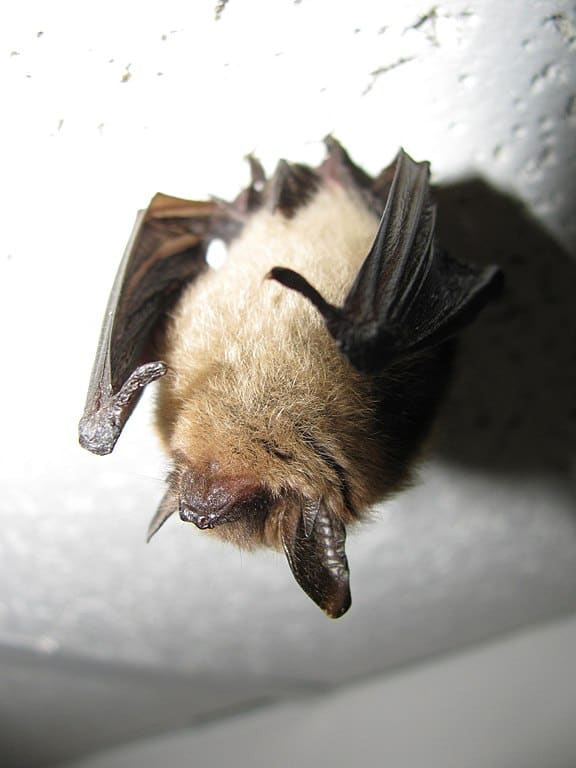
The northern long-eared bat lives in the Eastern half of the United States.
©Jomegat / CC BY-SA 3.0 – License
Native to North America, long-eared bats have no recognizable subspecies. These bats are small, weighing around 0.2 ounces, with a wingspan of nine to 10 inches. They have light brown fur and long, pointed ears extending well past their nose. These bats live in forested habitats, particularly boreal forests, throughout the Eastern half of the United States and Canada.
Long-eared bats roost in trees and artificial structures during the spring and summer, choosing new spots typically every other day. During the fall and winter, these bats migrate to caves where they hibernate. Unlike other bats, they do not capture moths and other insects during flight. Instead, they forage under forest canopies using echolocation.
7. Tricolored Bat (Perimyotis subflavus)
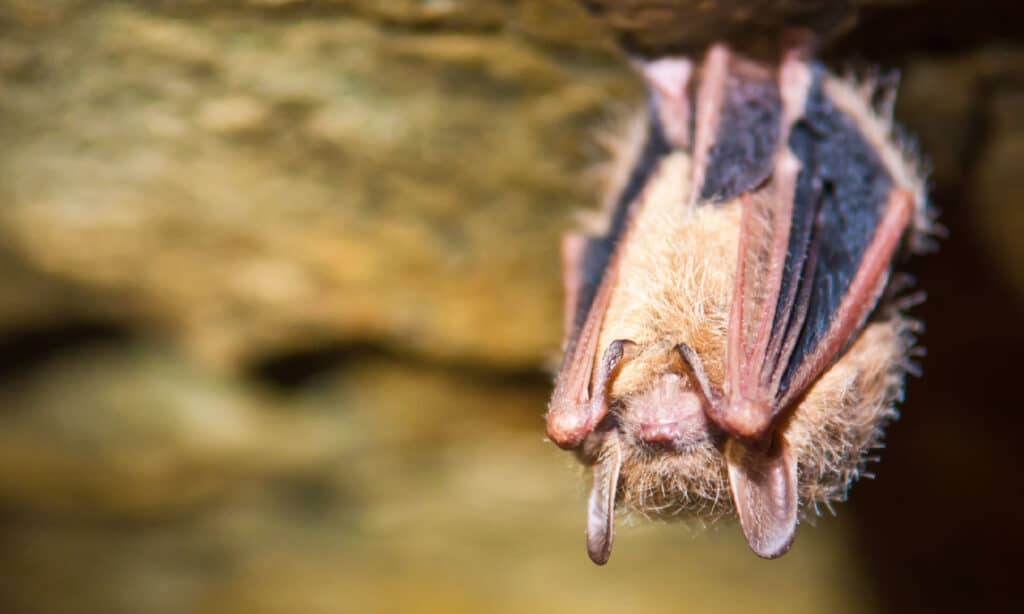
Tricolored bats are the most miniature bats in the Eastern United States, weighing as little as 0.16 ounces.
©iStock.com/JasonOndreicka
The tricolored bat, also known as the eastern pipistrelle, is a microbat that inhabits eastern North America. This species has a multi-colored back, with distinctive bands of dark gray, yellowish-brown, and reddish-brown. Weighing as tiny as 0.16 ounces, it is the most miniature bat in the Eastern and Midwestern United States.
Tricolored bats were once abundant in their range but have declined from fungal infections. They are also among the few bat species with the most US rabies deaths. Male tricolored bats prefer to roost alone in tree foliage, while females roost in trees such as oak or maple in small groups. They fly in erratic movements as they forage for insects near the forest’s edge.
These seven types of bats on the Mississippi River thrive near water, living in dense forest habitations and foraging for insects.
The photo featured at the top of this post is © Ondrej Prosicky/Shutterstock.com
Thank you for reading! Have some feedback for us? Contact the AZ Animals editorial team.




